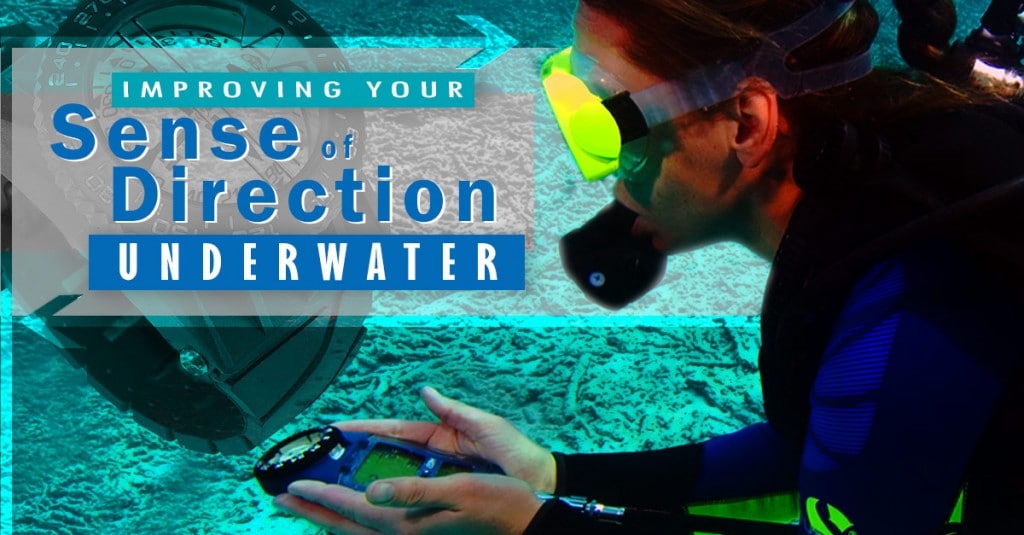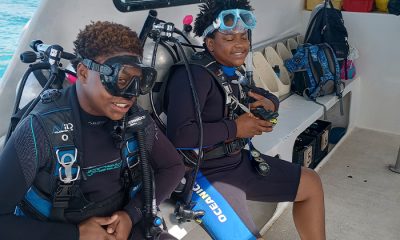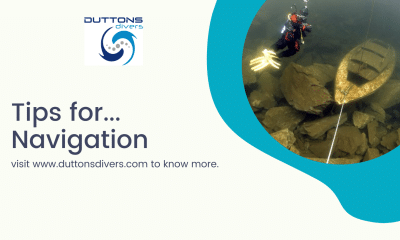News
Improving your sense of direction underwater

By: Kate Heller
Where’s the boat? Did we pass this part of the reef already? Should we just go up? Whether it happens to a new diver or an experienced one, there will more than likely come a time where navigating under water will become difficult. For a new diver who’s excited to experience the underwater world without an instructor, the difficulty might come when it’s time to head back to the boat or when the buddy team gets turned around. An experienced diver might have trouble when diving in a new place where conditions are not what they are accommodated to. For instance, a diver who is used to the visibility in an ocean and travels to a quarry and experiences less than decent visibility for the first time. All the silt from the bottom that’s been stirred up from the day before could cause the diver to lose track of their surroundings. This is when being not only being able to navigate underwater with a compass comes in handy, but when other methods of navigation can and should be utilized as well.
1. Know your compass
A diver should know what the parts of a compass are and what they are used for.
The card is the part of the compass that always points to the north. It will display N, S, E, and W on it. The card is shaped a bit like a dome with degrees shown on the face. These numbers will allow the diver to see what direction they are traveling, for example, 45 degrees SW.
The lubber line is used to point the buddy team in the direction they want to go. The person in charge of the compass should hold it out in front of them and in line with their body.
The side window of a compass is used along with the lubber line. When the lubber line is pointed in the direction the buddy team wants to travel, that window shows the degree to which the team is heading.
The bezel remembers the original degree the team wanted to travel. Once the lubber line is set in the direction of travel, the leader of the buddy team will have to turn the bezel to where the card points to North. Make sure to put the “N” between the two tick marks on the bezel.
2. Listen to the boat briefing or ask a dive shop about a particular shore site.
Knowing a bit more about the orientation at any given site will not only help you plan your dive based on what you want to see but also help you with navigating. Often times a briefing from a crew member on the boat will include what to look for from any given point of the boat (bow, stern, port, and star port side).
3. Elect and follow a leader.
When planning a dive within a buddy team you’ll want to delegate a person as the leader. This person is going to be in charge of the compass. So as to not leave the other member of the team out, they will need to help guide the leader by looking out for obstacles, as well as possible landmarks.
4. Monitor your time.
On a boat, the captain will normally give you an amount of time that they’ll allow divers to stay underwater. Using and dive computer as a reference of time will help you to do a little math to figure out how long the buddy team has to look at the underwater world as well as having enough time to return. If a dive is being planned for a shore dive, the buddy team will want to decide on a time collectively. In both cases, the buddy team will need to make it a point to set their air limits to stay safe.
5. Get to know your surroundings.
Keeping in mind the dive briefing for the site the team is at, the next step would be to look around at your surroundings and keep in mind what you’ve seen around the boat. Once the buddy team has decided on a direction to travel, made a note of the degree you’ll need to travel back to the boat on your compass, and set your lubber line for the direction you want to travel, the team can continue on their adventure. Once you’re on your way, look for the landmarks along the way and either make a mental note of them or write them on a slate if you have one. This will help you to follow a path if one is not apparent underwater. However, sometimes there are paths underwater. If you’re on a reef you might find yourself swimming between a couple rock formations with corals and schools of fish hanging around. You can follow this path and make a note of the things you see to keep yourselves on track. In the same respect, on a shore dive, you might be able to follow a trail made in the sand by waves. Remember to check your compass as well as your air and time to be sure you’re staying within those limits.
6. Stop, Look, Listen.
If for some reason the bezel on the compass got bumped and you can’t remember the directional degree the boat was, then you’ll want to keep in mind these tips. First, stop and think about your dive thus far. Second, look around for the landmarks that you made notes of along the dive. Third, listen for the boat’s engine. Remember sounds travels 4 times faster underwater than on land and although it might be harder to depict where the sounds are coming from, you might be able to pick out the general direction of the boat. If all else fails and you think you might be way off course, ascend at the appropriate rate and look for the boat at the surface. Once you spot the boat, take a new heading in the direction of the boat and follow that. If you are doing a shore dive you can look at the pattern in the sand and follow that to shore. You’ll quickly notice that your depth gets shallower and shallower.
7. Practice.
Like anything else in life, the best thing you and a buddy team can do for your skills is to practice. To do that all you need to do is get out and dive. Remember to incorporate your compass and other navigational skills into every dive you do and you’ll keep getting better and learning more about navigating in an underwater environment.
Navigating under water to new divers can seem intimidating without a guide or knowledge of the dive site, but with these tips in mind, it will become easier. Eventually, navigating under water will become second nature.
To find out more about International Training, visit www.tdisdi.com.

Blogs
Northern Red Sea Reefs and Wrecks Trip Report, Part 3: The Mighty Thistlegorm

Jake Davies boards Ghazala Explorer for an unforgettable Red Sea diving experience…
Overnight, the wind picked up, making the planned morning dive a bit bumpy on the Zodiacs to the drop point on Thomas Reef. There, we would dive along the reef before descending through the canyon and then passing under the arch before ascending the wall with a gentle drift. The site provided great encounters with more pelagic species, including shoals of large barracuda, tuna, and bigeye trevally.
Once back on the boat, it was time to get everything tied down again as we would head back south. This time, with the wind behind us, heading to Ras Mohammed to dive Jackfish Alley for another great gentle drift wall dive before then heading up the coast towards the Gulf of Suez to moor up at the wreck of the Thistlegorm. This being the highlight wreck dive of the trip and for many onboard, including myself, it was the first time diving this iconic wreck. I had heard so much about the wreck from friends, and globally, this is a must on any diver’s list. Fortunately for us, there was only one other boat at the site, which was a rarity. A great briefing was delivered by Ahmed, who provided a detailed background about the wreck’s history along with all the required safety information as the currents and visibility at the site can be variable.

Kitting up, there was a lot of excitement on deck before entering the water and heading down the shoreline. Descending to the wreck, there was a light northerly current which reduced the visibility, making it feel more like the conditions that can be found off the Welsh coast. At 10m from the bottom, the outline of the wreck appeared as we reached the area of the wreck which had been bombed, as our mooring line was attached to part of the propeller shaft. Arriving on deck, instantly everywhere you looked there were many of the supplies which the ship was carrying, including Bren Carrier tanks and projectiles that instantly stood out.

We headed around the exterior, taking a look at the large propeller and guns mounted on deck before entering the wreck on the port side to take a look in the holds. It was incredible to see all the trucks, Norton 16H, and BSA motorcycles still perfectly stacked within, providing a real snapshot in time.

Overall, we had four dives on the Thistlegorm, where for all of the dives we were the only group in the water, and at times, there were just three of us on the whole wreck, which made it even more special, especially knowing that most days the wreck has hundreds of divers. Along with the history of the wreck, there was plenty of marine life on the wreck and around, from big green turtles to batfish, along with shoals of mackerel being hunted by trevally. Some unforgettable dives.

The final leg of the trip saw us cross back over the Suez Canal to the Gobal Islands where we planned to stay the night and do three dives at the Dolphin House for the potential of sharing the dive with dolphins. The site, which included a channel that was teeming with reef fish, especially large numbers of goatfish that swam in large shoals along the edge of the reef. These were nice relaxing dives to end the week. Unfortunately, the dolphins didn’t show up, which was okay as like all marine life they are difficult to predict and you can’t guarantee what’s going to be seen. With the last dive complete, we headed back to port for the final night where it was time to clean all the kit and pack before the departure flight the next day.

The whole week from start to finish on Ghazala Explorer was amazing; the boat had all the facilities you need for a comfortable week aboard. The crew were always there to help throughout the day and the chefs providing top quality food which was required after every dive. The itinerary providing some of the best diving with a nice mixture of wreck and reef dives. I would recommend the trip to anyone, whether it’s your first Red Sea liveaboard in the Red Sea or you’re revisiting. Hopefully, it’s not too long before I head back to explore more of the Red Sea onboard Ghazala Explorer.

To find out more about the Northern Red Sea reef and wrecks itineraries aboard Ghazala Explorer, or to book, contact Scuba Travel now:
Email: dive@scubatravel.com
Tel: +44 (0)1483 411590
Photos: Jake Davies / Avalon.Red
Blogs
Northern Red Sea Reefs and Wrecks Trip Report, Part 2: Wall to Wall Wrecks

Jake Davies boards Ghazala Explorer for an unforgettable Red Sea diving experience…
The second day’s diving was a day full of wreck diving at Abu Nuhas, which included the Chrisoula K, Carnatic, and Ghiannis D. The first dive of the day was onto the Chrisoula K, also known as the wreck of tiles. The 98m vessel remains largely intact where she was loaded with tiles which can be seen throughout the hold. The stern sits at 26m and the bow just below the surface. One of the highlights of the wreck is heading inside and seeing the workroom where the machinery used for cutting the tiles are perfectly intact. The bow provided some relaxing scenery as the bright sunlight highlighted the colours of the soft coral reef and the many reef fish.

Following breakfast, we then headed to the next wreck, which was the Carnatic. The Carnatic is an 89.9m sail steamer vessel that was built in Britain back in 1862. She ran aground on the reef back in 1869 and remains at 27m. At the time, she was carrying a range of items, including 40,000 sterling in gold. An impressive wreck where much of the superstructure remains, and the two large masts lay on the seafloor. The wooden ribs of the hull provide structures for lots of soft corals, and into the stern section, the light beams through, bouncing off the large shoals of glass fish that can be found using the structure as shelter from the larger predators that are found outside of the wreck.

The final wreck at Abu Nuhas was the Ghiannis D, originally called ‘Shoyo Maru,’ which was 99.5m long and built in Japan back in 1969 before becoming a Greek-registered cargo ship in 1980. The ship then ran aground on the reef on April 19th, 1983, and now sits at the bottom at a depth of 27m. Heading down the line, the stern of the ship remains in good condition compared to the rest of the hull. The highlight of the wreck, though, is heading into the stern section and down the flights of stairs to enter the engine room, which remains in good condition and is definitely worth exploring. After exploring the interior section of the ship, we then headed over to see the rest of the superstructure, where it’s particularly interesting to see the large table corals that have grown at the bow relatively quickly considering the date the ship sank. After surfacing and enjoying some afternoon snacks, we made sure everything was strapped down and secured as we would be heading north and crossing the Gulf of Suez, where the winds were still creating plenty of chop.

The next morning, it was a short hop to Ras Mohammed Nature Reserve for the next couple of days of diving. The 6am wake-up call came along with the briefing for the first site we would be diving, which was Shark & Yolanda. The low current conditions allowed us to start the dive at Anemone City, where we would drift along the steep, coral-filled wall. These dives involved drifts, as mooring in Ras Mohammed wasn’t allowed to protect the reefs. As a dive site, Shark & Yolanda is well-known and historically had a lot of sharks, but unfortunately not so many in recent years, especially not so early in the season. However, there was always a chance when looking out into the blue.

The gentle drift took us along the steep walls of the site, with plenty of anemone fish to be seen and a huge variety of corals. It wasn’t long into the dive before we were accompanied by a hawksbill turtle, who drifted with us between the two atolls before parting ways. Between the two reefs, the shallow patch with parts of coral heads surrounded by sand provided the chance to see a few blue-spotted stingrays that were mainly resting underneath the corals and are always a pleasure to see. With this being the morning dive, the early sunlight lit up the walls, providing tranquil moments. Looking out into the blue, there was very little to be seen, but a small shoal of batfish shimmering underneath the sunlight was a moment to capture as we watched them swim by as they watched us.

Towards the end of the dive, we stopped at the wreck of the Jolanda where the seafloor was scattered with toilets from the containers it was carrying. This provided a unique site to make a safety stop, which was also accompanied by a large barracuda slowly swimming by, along with a hawksbill turtle calmly swimming over the reef as the sun rays danced in the distance.
For the next dive, we headed north to the Strait of Tiran to explore the reefs situated between Tiran Island and Sharm El Sheik, which were named after the British divers who had found them. We started on Jackson before heading to Gordons Reef, where we also did the night dive. All the atolls at these sites provided stunning, bustling coral reefs close to the surface and steep walls to swim along, which always provided the opportunity to keep an eye out for some of the larger species that can be seen in the blue. Midwater around Jackson Reef was filled with red-toothed triggerfish and shoals of banner fish, which at times were so dense that you couldn’t see into the blue. Moments went by peacefully as we enjoyed the slow drift above the reef, watching these shoals swim around under the mid-afternoon sun.

The night dive at Gordon’s Reef was mainly among the stacks of corals surrounded by sand, which was great to explore under the darkness. After some time circling the corals, we came across what we were really hoping to find, and that was an octopus hunting on the reef. We spent the majority of the dive just watching it crawl among the reef, blending into its changing surroundings through changes in colour and skin texture. It’s always so fascinating and captivating to watch these incredibly intelligent animals, in awe of their ability to carry out these physical changes to perfectly blend into the reef. Before we knew it, it was time to head back to the boat to enjoy a well-deserved tasty dinner prepared by the talented chefs onboard.
Check in for the 3rd and final part of this series from Jake tomorrow!
To find out more about the Northern Red Sea reef and wrecks itineraries aboard Ghazala Explorer, or to book, contact Scuba Travel now:
Email: dive@scubatravel.com
Tel: +44 (0)1483 411590
Photos: Jake Davies / Avalon.Red
-

 News3 months ago
News3 months agoHone your underwater photography skills with Alphamarine Photography at Red Sea Diving Safari in March
-

 News3 months ago
News3 months agoCapturing Critters in Lembeh Underwater Photography Workshop 2024: Event Roundup
-

 Marine Life & Conservation Blogs2 months ago
Marine Life & Conservation Blogs2 months agoCreature Feature: Swell Sharks
-

 Blogs2 months ago
Blogs2 months agoMurex Resorts: Passport to Paradise!
-

 Blogs2 months ago
Blogs2 months agoDiver Discovering Whale Skeletons Beneath Ice Judged World’s Best Underwater Photograph
-

 Gear Reviews3 months ago
Gear Reviews3 months agoGear Review: Oceanic+ Dive Housing for iPhone
-

 Marine Life & Conservation2 months ago
Marine Life & Conservation2 months agoSave the Manatee Club launches brand new webcams at Silver Springs State Park, Florida
-

 News3 months ago
News3 months agoWorld’s Best Underwater Photographers Unveil Breathtaking Images at World Shootout 2023
















